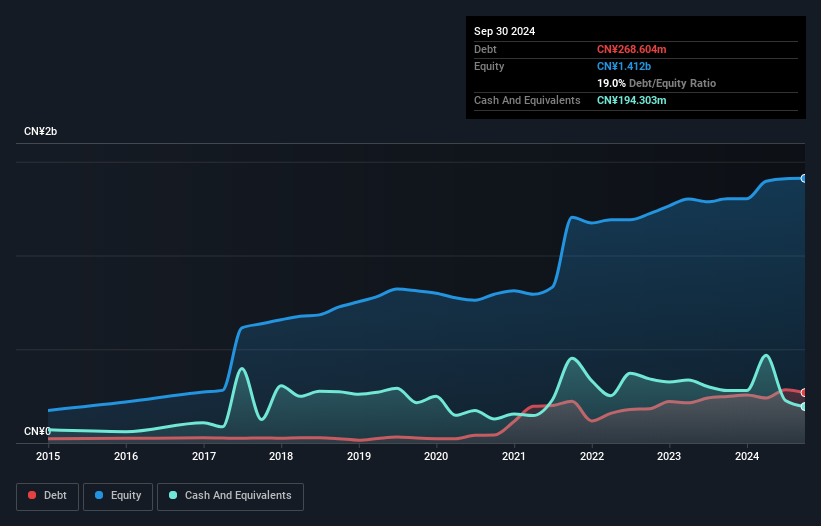- China
- /
- Communications
- /
- SHSE:603496
Does EmbedWay Technologies (Shanghai) (SHSE:603496) Have A Healthy Balance Sheet?
Legendary fund manager Li Lu (who Charlie Munger backed) once said, 'The biggest investment risk is not the volatility of prices, but whether you will suffer a permanent loss of capital.' So it might be obvious that you need to consider debt, when you think about how risky any given stock is, because too much debt can sink a company. We note that EmbedWay Technologies (Shanghai) Corporation (SHSE:603496) does have debt on its balance sheet. But the more important question is: how much risk is that debt creating?
Why Does Debt Bring Risk?
Debt is a tool to help businesses grow, but if a business is incapable of paying off its lenders, then it exists at their mercy. If things get really bad, the lenders can take control of the business. However, a more usual (but still expensive) situation is where a company must dilute shareholders at a cheap share price simply to get debt under control. By replacing dilution, though, debt can be an extremely good tool for businesses that need capital to invest in growth at high rates of return. When we examine debt levels, we first consider both cash and debt levels, together.
What Is EmbedWay Technologies (Shanghai)'s Debt?
You can click the graphic below for the historical numbers, but it shows that as of September 2024 EmbedWay Technologies (Shanghai) had CN¥268.6m of debt, an increase on CN¥248.1m, over one year. However, it does have CN¥194.3m in cash offsetting this, leading to net debt of about CN¥74.3m.

How Healthy Is EmbedWay Technologies (Shanghai)'s Balance Sheet?
Zooming in on the latest balance sheet data, we can see that EmbedWay Technologies (Shanghai) had liabilities of CN¥408.2m due within 12 months and liabilities of CN¥73.7m due beyond that. Offsetting this, it had CN¥194.3m in cash and CN¥484.7m in receivables that were due within 12 months. So it actually has CN¥197.0m more liquid assets than total liabilities.
This short term liquidity is a sign that EmbedWay Technologies (Shanghai) could probably pay off its debt with ease, as its balance sheet is far from stretched. Carrying virtually no net debt, EmbedWay Technologies (Shanghai) has a very light debt load indeed.
Check out our latest analysis for EmbedWay Technologies (Shanghai)
We measure a company's debt load relative to its earnings power by looking at its net debt divided by its earnings before interest, tax, depreciation, and amortization (EBITDA) and by calculating how easily its earnings before interest and tax (EBIT) cover its interest expense (interest cover). The advantage of this approach is that we take into account both the absolute quantum of debt (with net debt to EBITDA) and the actual interest expenses associated with that debt (with its interest cover ratio).
EmbedWay Technologies (Shanghai) has a low net debt to EBITDA ratio of only 0.47. And its EBIT easily covers its interest expense, being 41.8 times the size. So we're pretty relaxed about its super-conservative use of debt. Better yet, EmbedWay Technologies (Shanghai) grew its EBIT by 302% last year, which is an impressive improvement. If maintained that growth will make the debt even more manageable in the years ahead. There's no doubt that we learn most about debt from the balance sheet. But it is future earnings, more than anything, that will determine EmbedWay Technologies (Shanghai)'s ability to maintain a healthy balance sheet going forward. So if you're focused on the future you can check out this free report showing analyst profit forecasts.
Finally, a business needs free cash flow to pay off debt; accounting profits just don't cut it. So we clearly need to look at whether that EBIT is leading to corresponding free cash flow. During the last three years, EmbedWay Technologies (Shanghai) burned a lot of cash. While investors are no doubt expecting a reversal of that situation in due course, it clearly does mean its use of debt is more risky.
Our View
The good news is that EmbedWay Technologies (Shanghai)'s demonstrated ability to cover its interest expense with its EBIT delights us like a fluffy puppy does a toddler. But the stark truth is that we are concerned by its conversion of EBIT to free cash flow. Taking all this data into account, it seems to us that EmbedWay Technologies (Shanghai) takes a pretty sensible approach to debt. That means they are taking on a bit more risk, in the hope of boosting shareholder returns. The balance sheet is clearly the area to focus on when you are analysing debt. However, not all investment risk resides within the balance sheet - far from it. For example, we've discovered 1 warning sign for EmbedWay Technologies (Shanghai) that you should be aware of before investing here.
At the end of the day, it's often better to focus on companies that are free from net debt. You can access our special list of such companies (all with a track record of profit growth). It's free.
The New Payments ETF Is Live on NASDAQ:
Money is moving to real-time rails, and a newly listed ETF now gives investors direct exposure. Fast settlement. Institutional custody. Simple access.
Explore how this launch could reshape portfolios
Sponsored ContentValuation is complex, but we're here to simplify it.
Discover if EmbedWay Technologies (Shanghai) might be undervalued or overvalued with our detailed analysis, featuring fair value estimates, potential risks, dividends, insider trades, and its financial condition.
Access Free AnalysisHave feedback on this article? Concerned about the content? Get in touch with us directly. Alternatively, email editorial-team (at) simplywallst.com.
This article by Simply Wall St is general in nature. We provide commentary based on historical data and analyst forecasts only using an unbiased methodology and our articles are not intended to be financial advice. It does not constitute a recommendation to buy or sell any stock, and does not take account of your objectives, or your financial situation. We aim to bring you long-term focused analysis driven by fundamental data. Note that our analysis may not factor in the latest price-sensitive company announcements or qualitative material. Simply Wall St has no position in any stocks mentioned.
About SHSE:603496
EmbedWay Technologies (Shanghai)
Engages in the provision of network visibility, intelligent system platforms, and intelligent computing solutions and services in China.
High growth potential with adequate balance sheet.
Market Insights
Weekly Picks

THE KINGDOM OF BROWN GOODS: WHY MGPI IS BEING CRUSHED BY INVENTORY & PRIMED FOR RESURRECTION


Why Vertical Aerospace (NYSE: EVTL) is Worth Possibly Over 13x its Current Price


The Quiet Giant That Became AI’s Power Grid
Recently Updated Narratives


MINISO's fair value is projected at 26.69 with an anticipated PE ratio shift of 20x


Fiverr International will transform the freelance industry with AI-powered growth

Stride Stock: Online Education Finds Its Second Act
Popular Narratives


MicroVision will explode future revenue by 380.37% with a vision towards success


Crazy Undervalued 42 Baggers Silver Play (Active & Running Mine)





